Posts Tagged: solar
Pollinator Habitat: Important Part of Solar Energy Study
Solar energy should not only be used to benefit global sustainability, but to protect our global...
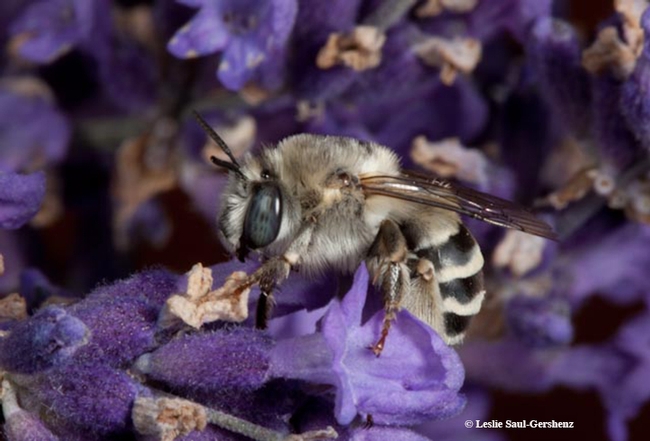
Solar energy can be used to protect pollinator habitat, according to a research paper published July 9 in the journal Nature. This is Anthophora urbana, a ground-nesting solitary bee which has a broad distribution including the Mojave Desert. It is a floral generalist collecting pollen and nectar from many species of plants, says UC Davis entomologist Leslie Saul-Gershenz. (Photo by Leslie Saul-Gershenz)
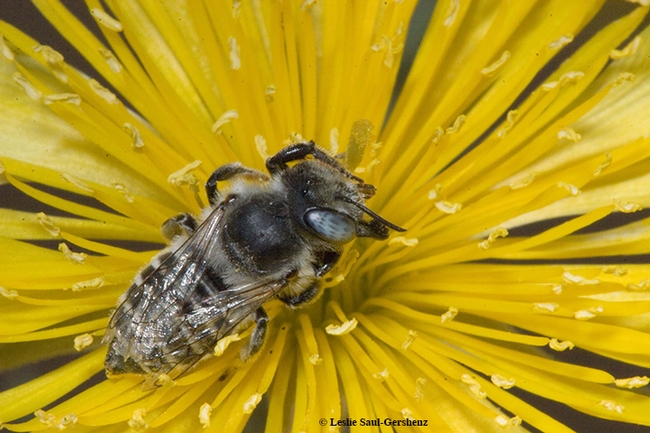
Native bee Megachile sp. on Mentzelia flower in the Mojave Desert. (Photo by Leslie Saul-Gershenz)
KARE completes new solar energy project.
KARE's new solar energy project has been completed. PG&E did their final safety checks for the new 42 kW solar system located at our Postharvest Facility. This brings KARE's solar output to about 65 kW. Special thanks to JKB Energy, Bob Ray, Patrick West, Andy Padilla, Santiago Aldana, Rudy Gonzales, Dan Mulligan, and Dale Pattigan for all of their hard work in helping to get this done. KARE will continue to get more green technologies on the Center. We continually strive to lower our carbon footprint and look at new and innovative ways to bring green technologies to our farming operations.

Kearney's solar panels north of the postharvest laboratories.
New solar array constructed at Kearney
The solar array at the UC Kearney Agricultural Research and Extension Center has been completed. Robert Ray, superintendent of the physical plant, said it will be integrated into the PG&E grid within a month and begin generating electricity for the F. Gordon Mitchell Post Harvest Laboratory, the sensory laboratory and a plant and sample handling lab. Below are photos of the construction process. Infrastructure has already been installed underground to expand the array when funds become available.
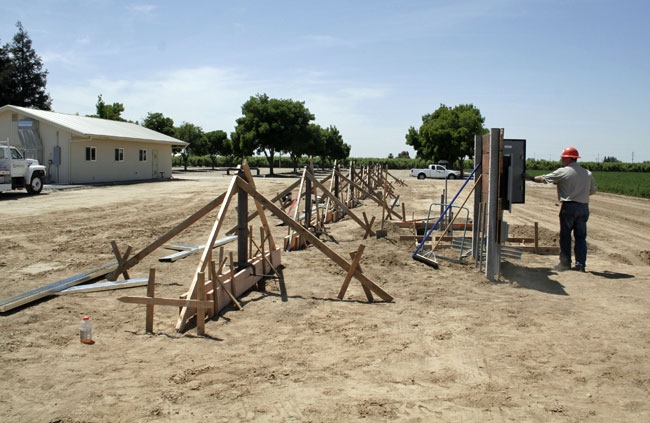
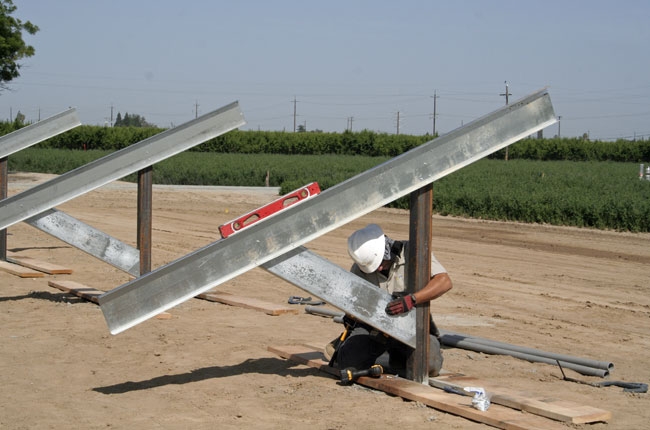
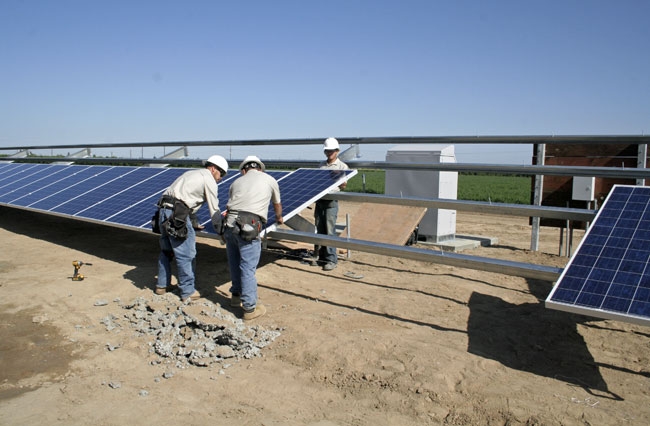
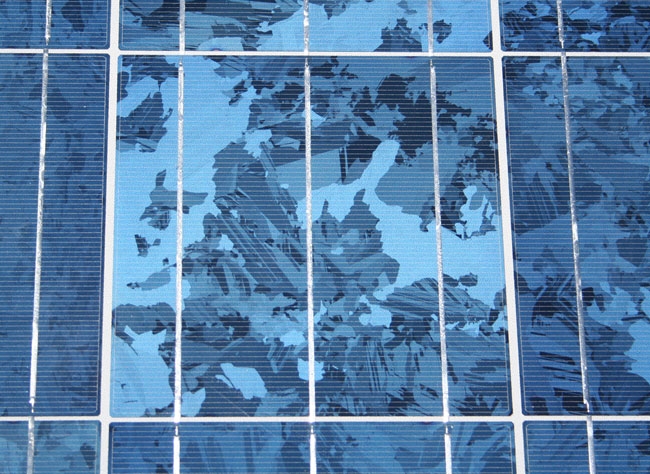
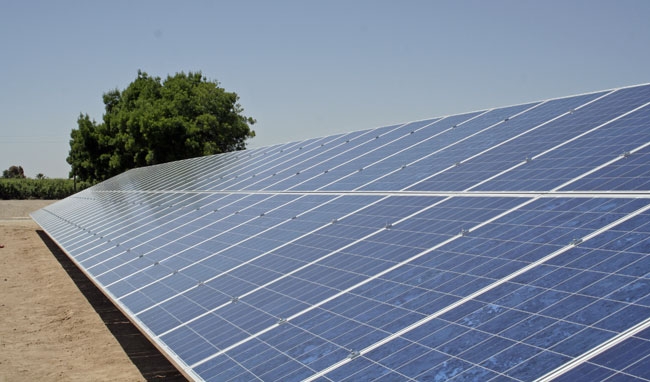
Kearney goes solar
An 80-panel solar array is being installed at the Kearney Agricultural Research and Extension Center to provide clean, green energy to the F. Gordon Mitchell Postharvest Laboratory, the sensory laboratory and a plant and sample handling lab. Initially, the array will generate 22.4 kilowatts of electricity per hour, a supply expected to cut the center's energy expenditures by $5,400 per year.
"We have a significant amount of electrically intensive equipment in the post harvest laboratory," said Robert Ray, superintendent of the physical plant at Kearney and coordinator of the project. "The laboratory includes a washer-waxer, fruit sizer, reach-in refrigeration boxes and sub-zero refrigeration units, among other equipment. The three facilities consume about 260,000 kilowatt hours of electricity per year."
Development of the solar farm is being supported by UC Agriculture and Natural Resources with a $100,000 allocation. Installation of the ground-mounted panels by JKB Energy of Turlock is expected to begin in early May.
"This is our first step toward developing renewable energy sources at the research and extension centers," said Luzanne Martin, a project manager for the nine-center system that stretches from Desert Research and Extension Center, near the border with Mexico, to the Intermountain Research and Extension Center, just south of Oregon. "We hope it will be a model project. When we see the savings we will try to look for renewable-energy options at our other centers and expand the array at Kearney."
Kearney facility and field staff are preparing a 140-by-25-foot area north of the post harvest laboratory and east of the sensory lab by leveling the land, pulling out alfalfa and installing underground conduits.
Ray said the solar farm will be expanded when funds become available to generate 78 kilowatts per hour, the maximum offset for the post harvest meter based on limits set by the Public Utilities Commission. In the future, solar arrays could also be built to provide the electrical needs of other Kearney facilities.
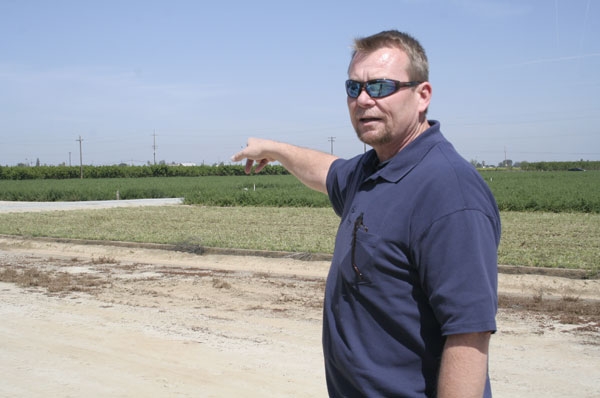
Robert Ray points out the area where the solar array will be installed in early May.
Solar tents help stop the spread of weeds at remote sites
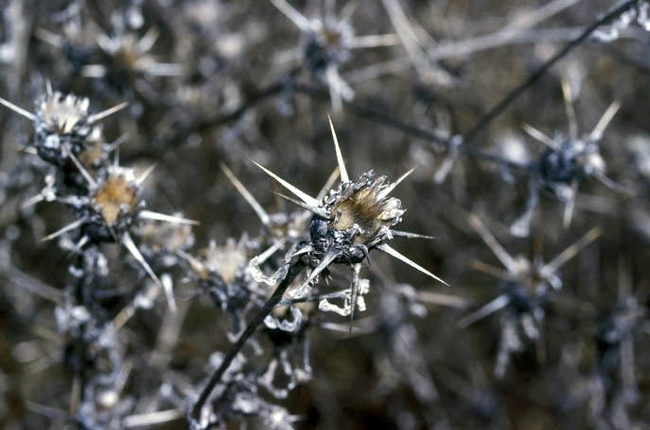
Research by Jim Stapleton, a UC Cooperative Extension advisor and Statewide Integrated Pest Management Program Coordinator for Natural Resources, based at the Kearney Agricultural Research and Extension Center, was published as Feasibility of solar tents for inactivating weedy plant propagative material in the March 2012 issue of the Journal of Pest Science.
Stapleton was inspired to conduct the study when a fire crew came upon a patch of Iberian starthistle growing along a stream in the Sierra foothills near Mariposa. Iberian starthistle is a robust, spiny weed native to the Middle East that, left unchecked, can dominate entire landscapes.
“Crews were going through and cutting dried plants and stacking them, but the seeds survived,” Stapleton said. “If you start moving plant material around with viable seeds, seeds are liable to spread, making the problem worse instead of better.”
Iberian starthistle is only one of many exotic, invasive plants that are capable of transforming California’s open areas into useless and unsightly tracts of land. On rangeland, for example, such weeds diminish desirable annual rangeland feed for cattle and wildlife. Weeds can shade out native wildflowers, make recreational areas inaccessible and, in dense infestations, become a fire laddering fuel.
In the past, such weeds may have been stacked and burned, but fire danger and air quality regulations have forced land managers to find alternatives.
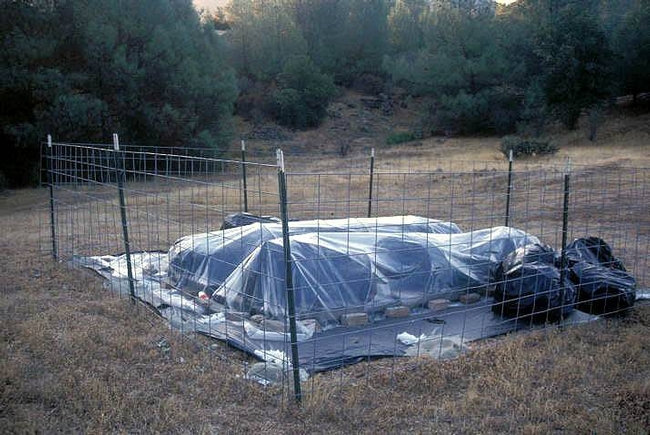
“You wouldn’t want to try this on a 40-acre area,” Stapleton said. “Eradication of weeds with solar tents is best suited for small-scale weed infestations in warm climates.”
For the research project, Stapleton constructed three replicate solar tents with concrete rubble, mulberry shoots and clear plastic tarps. He placed johnsongrass rhizomes inside black trash bags along with about one cup of water. The sample bags were left inside the solar tents for 72 hours.
“Regardless of where you are, regardless of financial resources, you should be able to construct a solar tent,” Stapleton said. “Most of the materials needed – rocks and sticks – are easy to find on site.”
Air temperature inside the sample bags rose to 158 degrees Fahrenheit. Over the three days of the experiment, the rhizomes were exposed to temperatures 140 degrees and higher for 10 hours. None of the rhizome segments treated for three days in the solar tents sprouted. In contrast, rhizomes maintained in clear vegetable storage boxes and kept indoors for comparison all sprouted.
Annotated diagrams for suggested construction of solar tents can be found on the UC Solarization website.